The Vaccine Transport Carrier Market is estimated to be valued at USD 3.0 billion in 2025 and is projected to reach USD 4.7 billion by 2035, registering a compound annual growth rate (CAGR) of 4.7% over the forecast period.
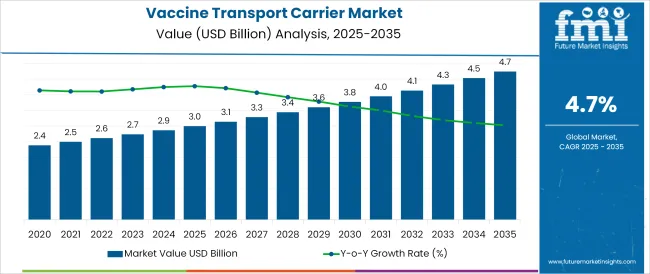
The vaccine transport carrier market is undergoing sustained expansion due to the growing emphasis on cold chain integrity, immunization logistics, and regulatory compliance for temperature-sensitive pharmaceuticals. Global vaccination drives, especially in rural and remote geographies, have intensified demand for reliable thermal storage and transport systems that maintain optimal temperature ranges without compromising efficacy.
Technological advancements in phase change materials, long-duration insulation, and IoT-enabled monitoring systems have significantly improved carrier performance. Increased government investments, multilateral immunization campaigns, and public-private healthcare partnerships are further contributing to market maturity.
Additionally, compliance with WHO PQS (Performance, Quality and Safety) standards and national health mandates has accelerated product standardization and procurement cycles. Looking ahead, innovations in durability, lightweight design, and eco-conscious insulation materials are expected to shape future product development and deployment strategies across the globe.
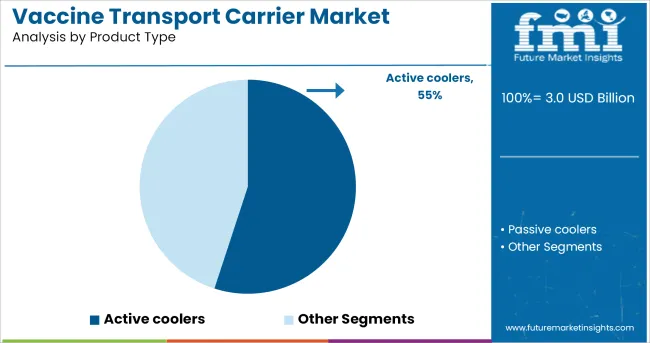
The active coolers category accounts for 55.0% of the product type segment, making it the dominant sub-segment in 2025. This lead is attributed to their consistent cooling performance, ability to operate autonomously, and longer temperature retention capabilities compared to passive solutions.
Active systems are favoured in high-volume immunization programs where uninterrupted temperature maintenance is essential for sensitive biologics. The integration of digital temperature monitoring and rechargeability has enhanced reliability, particularly in low-resource or off-grid settings.
These carriers are also preferred in centralized supply chains and mass distribution initiatives due to their ability to handle large vaccine loads while ensuring minimal thermal excursion. As a result, active coolers have emerged as the most trusted solution for maintaining cold chain integrity in diverse logistical scenarios.
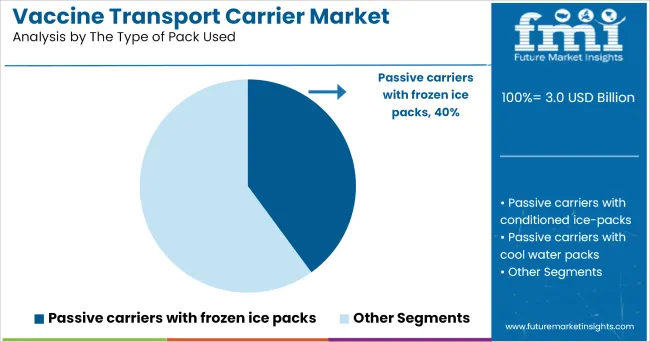
It is observed that passive carriers with frozen ice packs constitute 40.0% of market share under the pack type segment. Their prominence is attributed to affordability, ease of use, and independence from electricity or mechanical parts, which makes them particularly viable for last-mile delivery in rural or underdeveloped regions.
These carriers are commonly used in outreach campaigns and short-range vaccine transportation, where infrastructure constraints limit the use of powered equipment. Standardization through WHO PQS certifications has ensured global trust in their thermal performance, while innovations in pack design and insulation have improved usability and reduced freeze risk.
Their operational simplicity and logistical efficiency continue to support their wide-scale deployment, especially where cost-effective, short-duration cold chain solutions are prioritized.
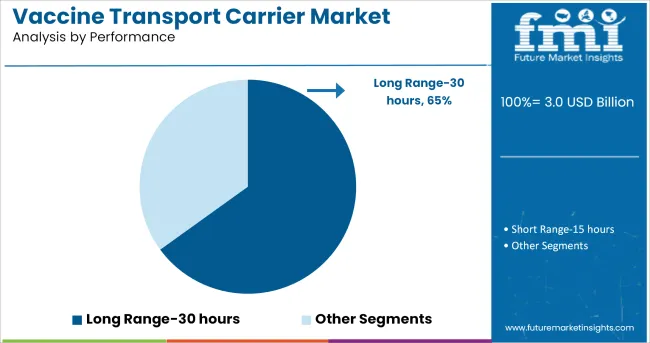
The long-range (30 hours) performance segment leads with 65.0% of the overall share in 2025, reflecting its dominance in the market. This segment’s strength lies in its ability to provide extended cold retention, reducing the risk of thermal excursion during long transit or in scenarios with unpredictable access to refrigeration.
Health agencies and humanitarian organizations have increasingly prioritized carriers that meet extended-duration requirements, especially for mass immunization drives and supply chains spanning remote geographies.
The demand for reduced intervention and improved logistic efficiency has led to growing reliance on long-range performance models. Additionally, their compatibility with both passive and active systems has further broadened their applicability across multiple use cases. The ability to support uninterrupted cold chains for over a full day of transport has positioned this segment as a critical enabler in global vaccine distribution strategies.
With the growth of many diseases all over the world, the need for transport and storage of vaccines to remote sites has increased; this fuels the vaccine transport carriers market. With the growing prevalence of infectious diseases, the reach for vaccines is increasing along with awareness about immunization among the people. The covid-19 pandemic has fueled the need for immunization which increased the demand for vaccine transport carriers.
The increasing number of pharmaceutical retailers and manufacturers along with the investments by biotechnological industries in the Research and development of new vaccines is driving the market growth. The major drivers of the market are reliability, efficiency, durability, and compactness provided by vaccine transport carriers for effective transportation of vaccines even to remote areas.
A large percentage of Vaccines produced around the world are temperature-sensitive, they require the ambient temperature to retain its quality. Vaccine transport carriers are the right solution to maintain the right temperature to avoid staggering losses.
To reach the population living in the remote parts of the world where there are no proper storage facilities healthcare workers require effective vaccine transport carriers. The vaccine carriers are also helpful to avoid high costs that might incur to discard the vaccines that are damaged.
Research and development of different vaccines also provide scope for the development of different transport carriers. Due to investments in the vaccine research and development activities by the government, the vaccine market is expected to grow at a rapid rate which will generate demand for Vaccine transport carriers. The rising focus on immunization among the population also added to the Vaccine transport carrier market growth.
The type of Vaccine carrier required depends on the type of vaccine being transported, the number of vaccines, the cold life required, and means of transport. Each vaccine is unique and is produced using different chemicals and technology, so there will be the requirement of Vaccine carriers with different specifications.
If a large number of vaccines are to be transported then a larger size carrier is required and the number of ice packs required will also increase. This will generate demand for a new variety of vaccine transport carriers and more revenues for the manufacturers.
The passive cooler vaccine transport carriers have higher demand when compared to the active vaccine transport carriers and is expected to increase over the next few years. The demand for mobile transport carriers will increase as they are easy to transport and compact models.
With the increase in demand for vaccines even from the remote parts of the country, safe mobility of the vaccines will become more important which accelerates the demand for mobile transport carriers.
Vaccine transport carriers using 2 ice packs are used mostly because of their smaller size and less weight which makes it easier for a health care worker to carry from one site to another site for immunization sessions. Demand for Vaccine transport carriers that are effective for a long duration will increase.
Based on the End users the demand from Hospitals, ambulances, and other medical facilities may increase in the coming future as the need for immunization is increasing among the population. A high cost that may incur to discard the damaged product is also a contributing factor.
North American region dominates the vaccine transport carrier market. The demand for vaccine transport carriers is expected to grow in the Asia Pacific region majorly from India and China because of the large population that is to be vaccinated. They are not widely used in Middle Eastern and African regions.
The demand from the Middle East and African regions is also expected to increase as the government is focusing and investing in the health care sector. Demand from the European region will also increase in the coming years because of an increase in demand for various vaccines from different places.
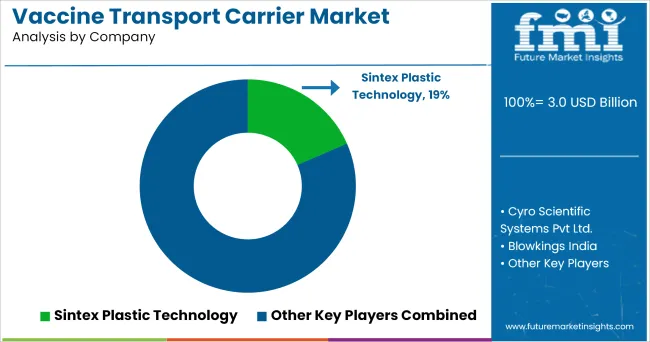
All the major players are focusing on developing new products that can withstand the low temperatures required for the vaccines. Their major focus is to develop a sturdy carrier that is easy to carry even to remote areas.
The global vaccine transport carrier market is estimated to be valued at USD 3.0 billion in 2025.
The market size for the vaccine transport carrier market is projected to reach USD 4.7 billion by 2035.
The vaccine transport carrier market is expected to grow at a 4.7% CAGR between 2025 and 2035.
The key product types in vaccine transport carrier market are active coolers and passive coolers.
In terms of the type of pack used, passive carriers with frozen ice packs segment to command 40.0% share in the vaccine transport carrier market in 2025.






Full Research Suite comprises of:
Market outlook & trends analysis
Interviews & case studies
Strategic recommendations
Vendor profiles & capabilities analysis
5-year forecasts
8 regions and 60+ country-level data splits
Market segment data splits
12 months of continuous data updates
DELIVERED AS:
PDF EXCEL ONLINE
Vaccine Preservatives Market Analysis - Size, Share, and Forecast Outlook 2025 to 2035
Vaccine Stabilizers Market Analysis - Size, Share, and Forecast Outlook 2025 to 2035
Vaccine Vial Rubber Stopper Market Size and Share Forecast Outlook 2025 to 2035
Vaccine Shippers Market Size and Share Forecast Outlook 2025 to 2035
Vaccines Market Insights - Trends, Growth & Forecast 2025 to 2035
Vaccine Packaging Market Growth - Demand & Forecast 2024 to 2034
Vaccine Ampoules Market
Dog Vaccine Market Size and Share Forecast Outlook 2025 to 2035
Cat Vaccines Market Size and Share Forecast Outlook 2025 to 2035
Fish Vaccines Market
Live Vaccines Market
Swine Vaccine Market Size and Share Forecast Outlook 2025 to 2035
Covid Vaccine Packaging Market Size and Share Forecast Outlook 2025 to 2035
Market Share Distribution Among Covid Vaccine Packaging Manufacturers
Nasal vaccines Market
Travel Vaccines Market Size and Share Forecast Outlook 2025 to 2035
Cancer Vaccines Market Analysis by Technology, Treatment Method, Application and Region from 2025 to 2035
Dengue Vaccines Analysis by Product Type by Product, By Age Group and by Distribution Channel through 2035
COVID-19 Vaccine Packaging & Delivery Devices Market - Innovations & Trends 2025 to 2035
Covid-19 Vaccine Development Tools Market - Growth & Forecast 2024 to 2034

Thank you!
You will receive an email from our Business Development Manager. Please be sure to check your SPAM/JUNK folder too.
Chat With
MaRIA